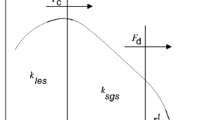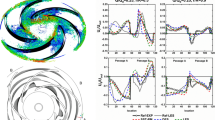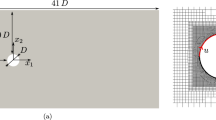Abstract
Three-dimensional Direct Numerical Simulations of statistically planar turbulent stratified flames at global equivalence ratios < ϕ > = 0.7 and < ϕ > = 1.0 have been carried out to analyse the statistical behaviour of the transport of co-variance of the fuel mass fraction Y F and mixture fraction ξ (i.e. \(\widetilde{Y_F^{\prime\prime} \xi ^{\prime\prime}}={\overline {\rho Y_F^{\prime\prime} \xi^{\prime\prime}} } \Big/ {\overline \rho })\) for Reynolds Averaged Navier Stokes simulations where \(\overline q \), \(\tilde{q} ={\overline {\rho q} } \big/ {\overline \rho }\) and \(q^{\prime\prime}= q-\tilde{q}\) are Reynolds averaged, Favre mean and Favre fluctuation of a general quantity q with ρ being the gas density and the overbar suggesting a Reynolds averaging operation. It has been found that existing algebraic expressions may not capture the statistical behaviour of \(\widetilde{Y_F^{\prime\prime} \xi^{\prime\prime}}\) with sufficient accuracy in low Damköhler number combustion and therefore, a transport equation for \(\widetilde{Y_F^{\prime\prime} \xi^{\prime\prime}}\) may need to be solved. The statistical behaviours of \(\widetilde{Y_F^{\prime\prime} \xi^{\prime\prime}}\) and the unclosed terms of its transport equation (i.e. the terms originating from turbulent transport T 1 , reaction rate T 4 and molecular dissipation \(\left( {-D_2 } \right))\) have been analysed in detail. The contribution of T 1 remains important for all cases considered here. The term T 4 acts as a major contributor in < ϕ > = 1.0 cases, but plays a relatively less important role in < ϕ > = 0.7 cases, whereas the term \(\left( {-D_2 } \right)\) acts mostly as a leading order sink. Through an a-priori DNS analysis, the performances of the models for T 1 , T 4 and \(\left( {-D_2 } \right)\) have been addressed in detail. A model has been identified for the turbulent transport term T 1 which satisfactorily predicts the corresponding term obtained from DNS data. The models for T 4 , which were originally proposed for high Damköhler number flames, have been modified for low Damköhler combustion. Predictions of the modified models are found to be in good agreement with T 4 obtained from DNS data. It has been found that existing algebraic models for \(D_2 =2\overline {\rho D\nabla Y_F^{\prime\prime} \nabla \xi^{\prime\prime}} \) (where D is the mass diffusivity) are not sufficient for low Damköhler number combustion and therefore, a transport equation may need to be solved for the cross-scalar dissipation rate \(\widetilde{\varepsilon }_{Y\xi } ={\overline {\rho D\nabla Y_F^{\prime\prime} \nabla \xi^{\prime\prime}} } \big/ {\overline \rho }\) for the closure of the \(\widetilde{Y_F^{\prime\prime} \xi^{\prime\prime}}\) transport equation.
Similar content being viewed by others
References
Ribert, G., Champion, M., Gicquel, O., Darabiha, N., Veynante, D.: Modeling nonadiabatic turbulent premixed reactive flows including tabulated chemistry. Combust. Flame 141, 271–280 (2005)
Robin, V., Mura, A., Champion, M., Plion, P.: A multi-Dirac presumed PDF model for turbulent reacting flows with variable equivalence ratio. Combust. Sci. Technol. 178, 1843–1870 (2006)
Mura, A., Robin, V., Champion, M.: Modeling of scalar dissipation in partially premixed turbulent flames. Combust. Flame 149, 217–224 (2007)
Malkeson, S.P., Chakraborty, N.: A-priori Direct Numerical Simulation analysis of algebraic models of variances and scalar dissipation rates for Reynolds Averaged Navier Stokes Simulations for low Damköhler number turbulent partially-premixed combustion. Combust. Sci. Technol. 182, 960–999 (2010)
Tarrazo, E., Sanchez, A., Linan, A., Williams, F.: A simple one-step chemistry model for partially premixed hydrocarbon combustion. Combust. Flame 147, 32–38 (2006)
Hélie, J., Trouvé, A.: Turbulent flame propagation in partially premixed combustion. Proc. Combust. Inst. 27, 891–898 (1998)
Grout, R., Swaminathan, N., Cant, R.S.: Effects of compositional fluctuations on premixed flames. Combust. Theory Model. 13, 823–832 (2009)
Eswaran, V., Pope, S.B.: Direct numerical simulations of the turbulent mixing of a passive scalar. Phys. Fluids 31, 506–520 (1988)
Chen, J.H., Choudhary, A., de Supinski, B., Devries, M., Hawkes, E.R., Klasky, S., Liao, W.K., Ma, K.L., Mellor-Crummey, J., Podhorski, N., Sankaran, R., Shende, S., Yoo, C.S.: Terascale direct numerical simulations of turbulent combustion using S3D. Comput. Sci. Discov. 2, 015001 (2009)
Bray, K.N.C., Domingo, P., Vervisch, L.: Role of the progress variable in models for partially premixed turbulent combustion. Combust. Flame 141, 431–437 (2005)
Veynante, D., Trouvé, A., Bray, K.N.C., Mantel, T.: Gradient and counter-gradient turbulent scalar transport in turbulent premixed flames. J. Fluid Mech. 332, 263–293 (1997)
Chakraborty, N., Cant, R.S.: Effects of Lewis number on turbulent scalar transport and its modelling in turbulent premixed flames. Combust. Flame 156, 1427–1444 (2009)
Malkeson, S.P., Chakraborty, N.: A-Priori DNS Modelling of the Turbulent Scalar Fluxes for Low Damköhler Number Stratified Flames. Combust. Sci. Technol. 184, 1680–1707 (2012). doi:10.1080/00102202.2012.690668
Jenkins, K.W., Cant, R.S.: DNS of turbulent flame kernels. In: Knight, D., Sakell, L., Beautner, T. (eds.) Proc. Second AFOSR Conf. on DNS and LES, pp. 192–202. Rutgers University, Kluwer Academic Publishers (1999)
Rogallo, R.S.: Numerical Experiments in Homogeneous Turbulence. NASA Technical Memorandum 81315. NASA Ames Research Center (1981)
Batchelor, G.K., Townsend, A.A.: Decay of turbulence in the final period. Proc. R. Soc. A 194, 527–543 (1948)
Peters, N.: Turbulent Combustion. Cambridge University Press, Cambridge (2000)
Poinsot, T., Lele, S.K.: Boundary conditions for direct simulation of compressible viscous flows. J. Comput. Phys. 101, 104–129 (1992)
Wray, A.A.: Minimal Storage Time Advancement Schemes for Spectral Methods. NASA Ames Research Center, California (1990). Report No. MS 202 A-1
Haworth, D., Blint, R., Cuenot, B., Poinsot, T.: Numerical simulation of turbulent propane-air combustion with nonhomogeneous reactants. Combust. Flame 121, 395–417 (2000)
Jimenez, C., Cuenot, B., Poinsot, T., Haworth, D.: Numerical simulation and modelling for lean stratified propane-air flames. Combust. Flame 128, 1–21 (2002)
Hawkes, E.R., Chen, J.H.: Direct numerical simulation of hydrogen-enriched lean premixed methane–air flames. Combust. Flame 138, 242–258 (2004)
Hawkes, E.R., Chen, J.H.: Evaluation of models for flame stretch due to curvature in the thin reaction zones regime. Proc. Combust. Inst. 30, 647–653 (2005)
Hawkes, E.R., Chen, J.H.: Comparison of direct numerical simulation of lean premixed methane–air flames with strained laminar flame calculations. Combust. Flame 144, 112–125 (2006)
Swaminathan, N., Bray, K.N.C.: Effect of dilatation on scalar dissipation in turbulent premixed flames. Combust. Flame 143, 549–565 (2005)
Swaminathan, N., Grout, R.: Interaction of turbulence and scalar fields in premixed flames. Phys. Fluids 18, 045102 (2006)
Echekki, T., Chen, J.H.: Unsteady strain rate and curvature effects in turbulent premixed methane-air flames. Combust. Flame 106, 184–202 (1996)
Echekki, T., Chen, J.H.: Analysis of the contribution of curvature to premixed flame propagation. Combust. Flame 118, 303–311 (1999)
Peters, N., Terhoeven, P., Chen, J.H., Echekki, T.: Statistics of flame displacement speeds from computations of 2-D unsteady methane-air flames. Proc. Combust. Inst. 27, 833–839 (1998)
Malkeson, S.P., Chakraborty, N.: The modeling of fuel mass fraction variance transport in turbulent stratified flames: a direct numerical simulation study. Numer. Heat Transf. A 58, 187–206 (2010)
Malkeson, S.P., Chakraborty, N.: Statistical analysis of scalar dissipation rate transport in turbulent partially premixed flames: a direct numerical simulation study. Flow Turbulence Combust. 86, 1–44 (2011)
Malkeson, S.P., Chakraborty, N.: Statistical analysis of cross scalar dissipation rate transport in turbulent partially premixed flames: a direct numerical simulation study. Flow Turbulence Combust. 87, 313–349 (2011)
Chakraborty, N., Swaminathan, N.: Influence of the Damköhler number on turbulence-scalar interaction in premixed flames. II. Model development. Phys. Fluids 19, 045104 (2007)
Chakraborty, N., Rogerson, J.W., Swaminathan, N.: A priori assessment of closures for scalar dissipation rate transport in turbulent premixed flames using direct numerical simulation. Phys. Fluids 20, 045106 (2008)
Kolla, H., Rogerson, J., Chakraborty, N., Swaminathan, N.: Scalar dissipation rate modelling and its validation. Combust. Sci. Technol. 181, 518–535 (2009)
Yamashita, H., Shimada, M., Takeno, T.: Numerical study on flame stability at the transition point of jet diffusion flames. Proc. Combust. Inst. 26, 27–34 (1996)
Libby, P.A., Williams, F.A.: A presumed PDF analysis of partially premixed turbulent combustion. Combust. Sci. Technol. 161, 351–390 (2000)
Robin, V., Mura, A., Champion, M., Plion, P.: Modélisation de la combustion turbulente des mélanges hétérogènes en richesse: Des flammes de prémélange aux flammes de diffusion. C. R. Mecanique 337, 596 (2009)
Nishiki, S., Hasegawa, T., Borghi, R., Himeno, R.: Modeling of flame generated turbulence using Direct Numerical Simulation databases. Proc. Combust. Inst. 29, 2017–2022 (2002)
Nguyen, P.D., Vervisch, L., Subramanian, V., Domingo, P.: Multidimensional flamelet-generated manifolds for partially premixed combustion. Combust. Flame 157, 43–61 (2010)
Author information
Authors and Affiliations
Corresponding author
Rights and permissions
About this article
Cite this article
Malkeson, S.P., Chakraborty, N. A-Priori Direct Numerical Simulation Modelling of Co-variance Transport in Turbulent Stratified Flames. Flow Turbulence Combust 90, 243–267 (2013). https://doi.org/10.1007/s10494-012-9430-z
Received:
Accepted:
Published:
Issue Date:
DOI: https://doi.org/10.1007/s10494-012-9430-z




